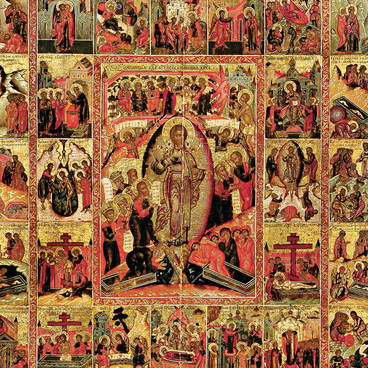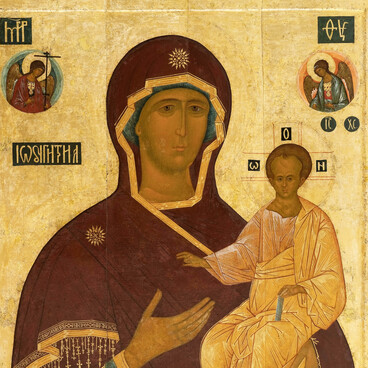The icon depicting the great martyr Nikita was painted by an unknown author in 1669. The icon was specially made for St. George’s Church in Murom. There was a side-chapel in honor of St. Nikita. This image was part of a group of the five icons, which the temple builder and warden Sidor Lopatin presented to it.
The centerpiece features the saint’s full-size image. He wears a richly decorated armor and a streaming red cloak, which is pinned on the chest. The saint’s hands are spread wide. He is holding a red cross - the symbol of martyrdom - in his right hand, and a sword lowered down in his left hand. The centerpiece is enclosed in a frame made in the shape of an ornament. It forms a semblance of an arch above the saint’s head.
Saint Nikita was a martyr-warrior. According to the hagiography, he came from the tribes of the Goths. Bishop Theophilus, who was an enlightener and participant to the first Ecumenical Council, converted him to Christianity. Shortly after that, the Gothic tribes started internecine wars, which brought the pagans came to power. St. Nikita was captured, tortured and burned at the stake in 327. Marian, a friend of St. Nikita and a Christian found the martyr’s body at night, carried it to Cilicia (the present-day Turkey) and buried it there. The relics of St. Nikita were subsequently transferred to Constantinople.
Along with the canonical hagiography of St. Nikita of Gothic, a translated apocryphal “Torture of Nikita” containing a number of miraculous details circulated in Rus since the 14-15th centuries. For example, there was a story about the single combat of Nikita with a demon in a dungeon. Thanks to this, the saint was especially revered in Rus as a helper in the fight against demons and was often depicted trampling on the demon.
The icon resembles the works of the Moscow icon painting school of 16th - the first half of 17th century. In comparison with the icons of the Moscow artists, painting techniques are strongly simplified and standardized here, the figures and the faces are more uniform and schematic, and the compositions of the marks seem a little overloaded. Some simplicity is also felt in the color palette. It is designed as a combination of several bright and saturated colors, almost without halftones and shades.
The centerpiece features the saint’s full-size image. He wears a richly decorated armor and a streaming red cloak, which is pinned on the chest. The saint’s hands are spread wide. He is holding a red cross - the symbol of martyrdom - in his right hand, and a sword lowered down in his left hand. The centerpiece is enclosed in a frame made in the shape of an ornament. It forms a semblance of an arch above the saint’s head.
Saint Nikita was a martyr-warrior. According to the hagiography, he came from the tribes of the Goths. Bishop Theophilus, who was an enlightener and participant to the first Ecumenical Council, converted him to Christianity. Shortly after that, the Gothic tribes started internecine wars, which brought the pagans came to power. St. Nikita was captured, tortured and burned at the stake in 327. Marian, a friend of St. Nikita and a Christian found the martyr’s body at night, carried it to Cilicia (the present-day Turkey) and buried it there. The relics of St. Nikita were subsequently transferred to Constantinople.
Along with the canonical hagiography of St. Nikita of Gothic, a translated apocryphal “Torture of Nikita” containing a number of miraculous details circulated in Rus since the 14-15th centuries. For example, there was a story about the single combat of Nikita with a demon in a dungeon. Thanks to this, the saint was especially revered in Rus as a helper in the fight against demons and was often depicted trampling on the demon.
The icon resembles the works of the Moscow icon painting school of 16th - the first half of 17th century. In comparison with the icons of the Moscow artists, painting techniques are strongly simplified and standardized here, the figures and the faces are more uniform and schematic, and the compositions of the marks seem a little overloaded. Some simplicity is also felt in the color palette. It is designed as a combination of several bright and saturated colors, almost without halftones and shades.



